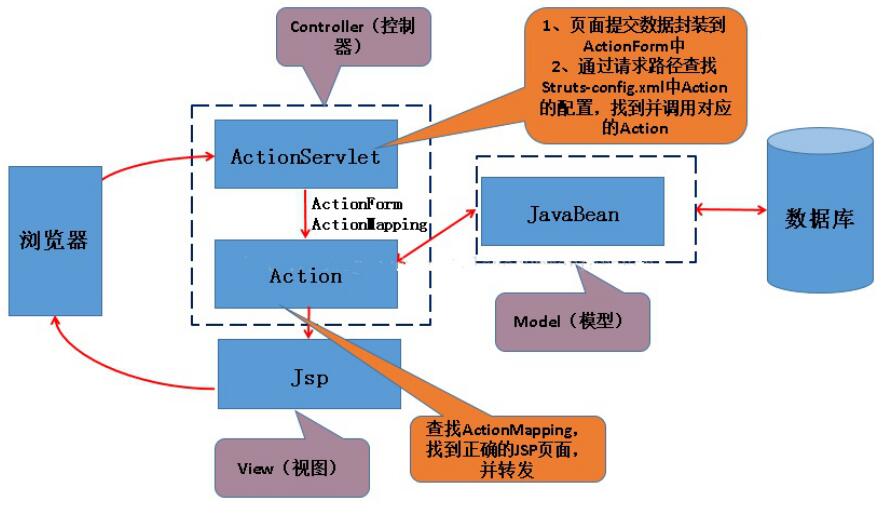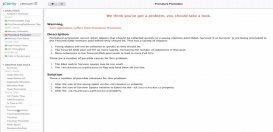struts调用流程如下图所示。

看到这幅图一下子就能了解了struts的原理。spring的核心就是ioc容器和aop,所以我们用spring主要是管理业务对象和事务的管理,所以主要是model层来让spring管理,这是我们的一种方案。
第一种集成方案在action中取得beanfactory
还记的在上篇文章中,测试的时候是在单元测试中拿到的beanfactory,与struts结合就是在action中取得beanfactory。步骤如下。
1、 建立一个web项目。
2、 建立相关页面,代码如下所示。
login.jsp代码入下所示。
|
1
2
3
4
5
6
7
8
9
10
11
12
13
14
15
16
|
<%@ pagelanguage="java" contenttype="text/html; charset=gb18030" pageencoding="gb18030"%><!doctype html public"-//w3c//dtd html 4.01 transitional//en""http://www.w3.org/tr/html4/loose.dtd"><html><head><metahttp-equiv="content-type" content="text/html;charset=gb18030"><title>insert titlehere</title></head><body> <formaction="login.do" method="post"> 用户:<input type="text"name="username"><br> 密码:<input type="password"name="password"><br> <inputtype="submit" value="登录"> </form></body></html> |
login_success.jsp
|
1
2
3
4
5
6
7
8
9
10
11
12
13
|
<%@ pagelanguage="java" contenttype="text/html; charset=gb18030" pageencoding="gb18030"%><!doctype html public"-//w3c//dtd html 4.01 transitional//en" "http://www.w3.org/tr/html4/loose.dtd"><html><head><metahttp-equiv="content-type" content="text/html;charset=gb18030"><title>insert titlehere</title></head><body> xx,用户登录成功! </body></html> |
3、 配置struts环境,关于struts的配置,拷贝struts和jstl的依赖包;在web.xml中配置actionservlet,提供struts-config.xml文件。前篇文中有说明,在此就不赘述了。
struts-config.xml代码如下所示。
|
1
2
3
4
5
6
7
8
9
10
11
12
13
14
15
|
<struts-config> <form-beans> <form-beanname="loginform"type="com.bjpowernode.usermgr.web.forms.loginactionform"></form-bean> </form-beans> <action-mappings> <actionpath="/login" type="com.bjpowernode.usermgr.web.actions.loginaction" name="loginform" scope="request" > <forwardname="success" path="/login_success.jsp"/> </action> </action-mappings> <message-resourcesparameter="resources.messageresources" /></struts-config> |
4、 配置spring环境,拷贝spring相关jar包,建立spring配置文件applicationcontext-beans.xml。
applicationcontext-beans.xml代码如下所示。
|
1
2
3
4
5
6
7
8
9
|
<beansxmlns="http://www.springframework.org/schema/beans" xmlns:xsi="http://www.w3.org/2001/xmlschema-instance" xmlns:aop="http://www.springframework.org/schema/aop" xmlns:tx="http://www.springframework.org/schema/tx" xsi:schemalocation="http://www.springframework.org/schema/beanshttp://www.springframework.org/schema/beans/spring-beans-2.0.xsd http://www.springframework.org/schema/aophttp://www.springframework.org/schema/aop/spring-aop-2.0.xsd http://www.springframework.org/schema/txhttp://www.springframework.org/schema/tx/spring-tx-2.0.xsd"> <beanid="usermanager"class="com.bjpowernode.usermgr.manager.usermanagerimpl"/></beans> |
5、 建立相关的action和actionform。代码如下所示。
loginaction.java代码如下所示。
|
1
2
3
4
5
6
7
8
9
10
11
12
13
14
15
|
public class loginaction extendsaction { @override publicactionforward execute(actionmapping mapping, actionform form, httpservletrequestrequest, httpservletresponse response) throwsexception { loginactionformlaf = (loginactionform)form; stringusername = laf.getusername(); stringpassword = laf.getpassword(); //但是我们每次都要去调用,去创建太麻烦了. //我们在这里只需要去配置listener就可以了,spring给实现好了. beanfactoryfactory = newclasspathxmlapplicationcontext("applicationcontext.xml"); usermanagerusermanager = (usermanager)factory.getbean("usermanager"); usermanager.login(username,password); }} |
loginactionform.java代码如下所示。
|
1
2
3
4
5
6
7
8
9
10
11
12
13
14
15
16
17
18
|
public class loginactionformextends actionform { //表单上有什么提供什么属性. //名字一定要与表单中的一样. privatestring username; publicstring getusername() { returnusername; } publicvoid setusername(string username) { this.username= username; } privatestring password; publicstring getpassword() { returnpassword; } publicvoid setpassword(string password) { this.password= password; }} |
6、 建立业务逻辑层,代码如下所示。
usermanager代码如下所示。
|
1
2
3
|
public interface usermanager { publicvoid login(string username, string password);} |
usermanagerimpl.java代码如下所示。
|
1
2
3
4
5
|
public class usermanagerimplimplements usermanager { publicvoid login(string username, string password) { system.out.println("usermanagerimpl"+"username="+ username); }} |
7、 web.xml配置文件代码如下所示。
|
1
2
3
4
5
6
7
8
9
10
11
12
13
14
15
16
17
|
<servlet> <servlet-name>action</servlet-name> <servlet-class>org.apache.struts.action.actionservlet</servlet-class> <init-param> <param-name>config</param-name> <param-value>/web-inf/struts-config.xml</param-value> </init-param> <init-param> <param-name>debug</param-name> <param-value>2</param-value> </init-param> <init-param> <param-name>detail</param-name> <param-value>2</param-value> </init-param> <load-on-startup>2</load-on-startup> </servlet> |
就这样我们在loginaction中,使用beanfactory读取spring配置文件,找到usermanagerimpl实例。如果每次在action中读取application-beans.xml文件,我们是否可以在服务器启动的时候就就创建beanfactory呢?在这里我们可以使用spirng的工具webapplicationcontextutils.getrequiredwebapplicationcontext()从 servletcontext中 取得beanfactory,然后再web.xml中配置spring的listener。
修改后,loginaction代码如下所示。
|
1
2
3
4
5
6
7
8
9
10
11
12
13
14
15
|
public class loginaction extendsaction { @override publicactionforward execute(actionmapping mapping, actionform form, httpservletrequestrequest, httpservletresponse response) throwsexception { loginactionformlaf = (loginactionform)form; stringusername = laf.getusername(); stringpassword = laf.getpassword(); //用工具包直接拿出来就可以了。 beanfactoryfactory =webapplicationcontextutils.getrequiredwebapplicationcontext(request.getsession().getservletcontext()); usermanagerusermanager = (usermanager)factory.getbean("usermanager"); usermanager.login(username,password); returnmapping.findforward("success"); }} |
加入相关配置,web.xml代码如下所示。
|
1
2
3
4
5
6
7
|
<context-param> <param-name>contextconfiglocation</param-name> <param-value>classpath:applicationcontext-*.xml</param-value> </context-param> <listener> <listener-class>org.springframework.web.context.contextloaderlistener</listener-class> </listener> |
这种方案缺点:
我们在在action中仍然看到spring相关东西,看到spring相关类,要是程序只看到的是接口,那要怎么做呢?
第二种方案,将struts的aciton交给spring来创建,让代理action负责拿到beanfactory,根据path名称到ioc中把对应的action取出来。
我们是在model层应用spring,在action中取得beanfactory,然后通过springioc来找到model层的bean。但是这这样存在一些问题,我们在action中使用的是spring相关的静态类,这就说明我们依赖的是spring的静态类,我们希望所依赖的是接口而不是类,符合设计原则,面向接口编程,这样也容易扩展和维护。于是在此基础上进行改进。
第二种方案是将struts的action交给spring创建,这样业务逻辑对象将被注入,这样就避免了依赖查找,而spring中会有一个代理action,通过代理actionproxy取得banfactory。方案一和方案二的对比图如下图所示。
这样就不用spring的listener了,所以我们的web.xml配置文件代码如下所示。
|
1
2
3
4
5
6
7
8
9
10
11
12
13
14
15
16
17
18
19
20
21
22
23
24
25
26
27
|
<?xml version="1.0" encoding="utf-8"?> <web-app version="2.4" xmlns="http://java.sun.com/xml/ns/j2ee" xmlns:xsi="http://www.w3.org/2001/xmlschema-instance" xsi:schemalocation="http://java.sun.com/xml/ns/j2ee http://java.sun.com/xml/ns/j2ee/web-app_2_4.xsd"> <welcome-file-list> <welcome-file>index.jsp</welcome-file> </welcome-file-list> <servlet> <servlet-name>action</servlet-name> <servlet-class>org.apache.struts.action.actionservlet</servlet-class> <init-param> <param-name>config</param-name> <param-value>/web-inf/struts-config.xml</param-value> </init-param> <init-param> <param-name>debug</param-name> <param-value>2</param-value> </init-param> <init-param> <param-name>detail</param-name> <param-value>2</param-value> </init-param> <load-on-startup>2</load-on-startup> </servlet> |
同时再struts的配置文件,struts-config.xml中,在<action-mappings>标签中配置action,也不再配置我们自己建立的action,而是配置spring自己的代理action。代码如下所示。
|
1
2
3
4
5
6
7
8
9
10
11
12
13
14
15
16
17
18
19
|
<?xml version="1.0" encoding="iso-8859-1" ?> <!doctype struts-config public "-//apache software foundation//dtd struts configuration 1.2//en" "http://jakarta.apache.org/struts/dtds/struts-config_1_2.dtd"> <struts-config> <form-beans> <form-bean name="loginform" type="com.bjpowernode.usermgr.web.forms.loginactionform"></form-bean> </form-beans> <action-mappings> <action path="/login" type="org.springframework.web.struts.delegatingactionproxy" name="loginform" scope="request" > <forward name="success" path="/login_success.jsp"/> </action> </action-mappings> <message-resources parameter="resources.messageresources" /> </struts-config> |
spring对aciton的配置文件如下所示。applicationcontext-actions.xml.
|
1
2
3
4
5
6
7
8
9
10
11
12
|
<?xml version="1.0" encoding="utf-8"?> <beans xmlns="http://www.springframework.org/schema/beans" xmlns:xsi="http://www.w3.org/2001/xmlschema-instance" xmlns:aop="http://www.springframework.org/schema/aop" xmlns:tx="http://www.springframework.org/schema/tx" xsi:schemalocation="http://www.springframework.org/schema/beans http://www.springframework.org/schema/beans/spring-beans-2.0.xsd http://www.springframework.org/schema/aop http://www.springframework.org/schema/aop/spring-aop-2.0.xsd http://www.springframework.org/schema/tx http://www.springframework.org/schema/tx/spring-tx-2.0.xsd"> <bean name="/login" class="com.bjpowernode.usermgr.web.actions.loginaction" scope="prototype"> <property name="usermanager" ref="usermanager"/> </bean> </beans> |
在这里配置对应的本系统实际的action,注意名字一定要和struts中代理action一致!并且设置每次创建一个新的action,而不是共用一个action,scope="prototype"。
这样在loginaction中,我们不用再看到创建model和工厂的细节,使用springioc,创建model,usermanager,并且配置文件中注入loginaction,这样loginaction代码如下所示。
|
1
2
3
4
5
6
7
8
9
10
11
12
13
14
15
16
17
|
public class loginaction extends action { private usermanager usermanager; // 让spring注入,loginaction让spring管理, 不是让strus创建而是由spring创建. public void setusermanager(usermanager usermanager) { this.usermanager = usermanager; } @override public actionforward execute(actionmapping mapping, actionform form, httpservletrequest request, httpservletresponse response) throws exception { loginactionform laf = (loginactionform) form; string username = laf.getusername(); string password = laf.getpassword(); usermanager.login(username, password); return mapping.findforward("success"); } } |
小结:
spring框架就相当于我们的工具,我们把工具挖掘和使用的淋漓尽致才好,这可能就是人和工具的区别,人利用创造和利用工具,工具被创造和被利用。这中间的过程就是磨合了。
原文链接:http://blog.sina.com.cn/s/blog_9c6852670102wvtr.html













